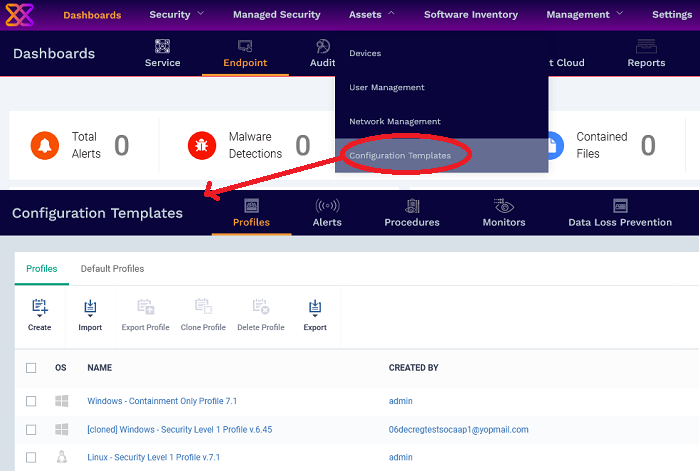Configuration Templates
The 'Configuration Templates' section lets you create and manage profiles for Android, iOS, Mac, Windows and Linux devices.
-
Each profile lets you specify a device's network access rights, overall security policy, antivirus scan schedule and other settings.
-
Once created, profiles can be applied to devices/device groups and users/user groups.
You can also add the following to a profile:
-
Procedures let you automate a range of tasks on your protected endpoints. Example procedures include patch installation, disk de-fragmentation and so on. Procedures can also be deployed as stand-alone instructions.
-
Monitors are scripts which track events on your endpoints and take specific actions if their conditions are met. For example, 'Alert me when a USB removable disk is connected to the system', or 'Create a log entry if CPU usage goes above 75% for a certain length of time'.
-
Alerts - You can configure monitors to generate alerts if their conditions are met.
- The 'Alerts' area contains templates which specify general settings for those alerts.
- For example, 'Create a notification in the portal', 'Send a notification to the following users'.
- You can create different alert templates and apply them to different monitors as required.
- Data loss prevention rules scan managed devices for files containing sensitive information. For example, credit card numbers and social security numbers.

The 'Configuration Templates' tab contains the following sub sections:
-
Profiles - A list of every profile added to Xcitium.
A profile lets you define a device's security policy, network access rights, antivirus scan schedule and other settings.
'Default Profiles' are applied to newly added devices if no user or user group profile exists. Default profiles are available for iOS, Android, Mac OS, Windows and Linux devices
You can mark custom profiles as 'default' if you wish.
Profiles can be applied to individual devices/users, device groups and user groups. You can add new profiles, export profiles, and import profiles.
-
Alerts - Alert templates govern what happens when you receive an alert from a procedure/monitor. For example, an alert template can tell Xcitium to send you a notification if the conditions of a monitor are met.
Unless you change it, the 'Default Alert' settings are applied to new monitors/procedures. Click 'Assets' > 'Configuration Templates' > 'Alerts' then click on 'Default Alert' to view these settings. You can also create custom alert templates as required.
See 'Manage Alerts' for more details.
-
Procedures - Contains a list of predefined and custom procedures that can be executed on enrolled devices. Procedures can be run ad-hoc on selected devices or scheduled in a profile to run at set intervals. See 'Manage Procedures' for more details.
-
Monitors - A monitor is a script which tracks events on your network and takes specific actions if its conditions are met. For example, 'Alert me when a USB removable disk is connected to the system', or 'Create a log entry if CPU usage goes above 75% for a certain length of time'.
You can add a monitor to a Windows profile by adding a 'Monitoring' section. See 'Manage Monitors' for more details.
- Data Loss Prevention - Data loss prevention (DLP) discovery rules let you scan managed devices for files that contain sensitive information. For example, credit card numbers, social security numbers etc.
- Discovery rules let you specify the areas you want to scan, and the type of data you want to search for.
- You then add the rules to profiles.
- See Data Loss Prevention Rules for help to configure the rules.
- You can view discovered files at 'Security' > 'Endpoint Security' > 'Data Loss Prevention'



